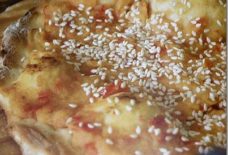Heritage Month: A Tribute to Arab American Food
By: Nisreen Eadeh/Arab America Contributing Writer
Aside from what’s said about Arab Americans in the news by demagogic politicians, Arab Americans are probably most known for their restaurants and cuisines found across the country. Some of the simple and classic dishes coming from the Arab World have been normalized in American society and have become popular dishes at all restaurants, not just ones owned and operated by Arab Americans.
The dish of all dishes, of course, is hummus. This simple puree of chickpeas, tahini, lemon, and garlic is best paired with anything placed next to it. Hummus is a common appetizer as restaurants of all varieties. It is used as a dip for vegetables, meat, and bread, a spreadable for sandwiches and hamburgers, and even a dressing on pasta and salads. Hummus also comes in many flavors, too, such as red pepper, chipotle, pesto, extra garlic, artichoke, pine nut roasted, and so many more. It is truly impressive how conceptual this dish has become in American society.
Even with all these innovations to hummus, some argue that its best use is on the side of shawarma. Sometimes called “street meat” in the U.S., shawarma with chicken, beef, lamb, or vegetarian has become another national hit thanks to Arab Americans. Wrapped with garlic and pickles in Arabic bread (aka pita bread in America today), shawarma has become the go-to sandwich for people eating on the go or those who are simply looking for an inexpensive meal. Again, it’s the simple ingredients of this meal that has made it a major contribution to American society.
Aside from meat and chickpeas, though, Arab heritage is nothing without its vegetables. Parsley is a delicate herb that is nearly tasteless, but when put into a bowl with tomatoes, onions, bulgur, mint, and lemon, parsley is transformed into tabbouleh – another Arab American dish found in many restaurants and all major grocery stores. Tabbouli is a healthy side dish turned the main course with its fresh flavors and aesthetic appeal. It can be scooped with lettuce and bread, or mixed with hummus.
Tabbouli is probably best paired with falafel, another food made from grounded chickpeas and parsley, that has also become famous for being a street food turned delicacy. Eat it plain, with hummus, tahini, or garlic, or in a sandwich wrap, either way, it’ll be delicious. Non-Arab Americans crave falafel and the food has become a comedic pop culture reference in television shows and movies of characters who just want nothing but to get a falafel sandwich.
Americans were a bit slow to accept falafel into everyday life, but one dish that’s been in the country for centuries as a hearty and healthy rice substitute is Moroccan couscous. This dish is paired with all kinds of meat, fish, and vegetables and sold dry by the box in every major grocery store in the country. So many non-Arab Americans make couscous now to the extent that it is no longer recognized as an Arab delicacy. Rather, couscous is simply an international staple.
There are some more difficult Arab dishes that are popular in American cuisine, one of them being grape leaves or dolma. Everyone loves meat and vegetarian grape leaves so much that they can be found in any Mediterranean restaurant, made fresh in grocery stores, and picked off the vines of fences surrounding the yards of American homes. Although grape leaves require some time to make, the ingredients are easily accessible; especially the leaves that are commonly sold in jars at the local Arab American grocery store or ethnic and international aisles at the big chain supermarkets.
These foods seem to have the biggest impact on American society, but there are several other Arab foods that have made their way into the hearts and bellies of Americans. Baba ghannoush; goat, Spanish, and string cheeses; spinach, meat, and cheese pies; fattoush; shish tawook; kifta; kunafa; and baklawa are popular all over the world, not just the U.S. The early Arab American migrants that had faith in American love for Arab cuisine were right.
For more information about National Arab American Heritage Month Click Here



